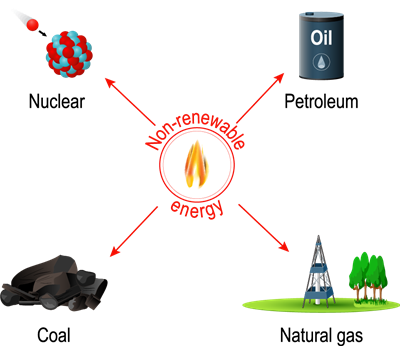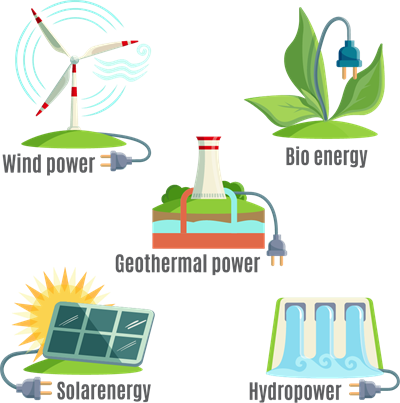PDF chapter test TRY NOW
In the previous theories, we studied the classification of natural resources. In this theory, let us focus on renewable and non-renewable energy resources.
Energy is a crucial component of development. The rate of agricultural and industrial development in every section of the world has been directly proportional to the increase of viable energy resources. There are two types of energy resources, namely:
1. Non-renewable energy resources
2. Renewable energy resources
Non-renewable or exhaustible energy resources:
Energy obtained from sources that cannot renew themselves over a short period of time is called non-renewable energy.
These resources do not regenerate themselves and are available in limited quantities in nature.
Example:
Coal, petroleum, nuclear power and natural gas are examples of non-renewable energy resources.

Non-renewable energy resources
Conventional or non-renewable energy resources provide for 90 \% of the world's commercial energy production, and nuclear power accounts for 10 \%.
Renewable or inexhaustible energy resources:
Energy resources available in an unlimited amount in nature, which can be renewed over a short period of time, are inexpensive and can be harvested continuously is called renewable energy.
They comprise non-conventional energy resources:
1. Biofuel
2. Biomass energy
3. Water energy (hydroelectric and tidal energy)
4. Geothermal energy
5. Solar energy
6. Wave energy, and
7. Wind energy.

Renewable energy resources
Differences between renewable and non-renewable energy resources:
Renewable energy | Non-renewable energy |
Renewable resources are renewed or replenished in a short period. | Non-renewable resources cannot renew or replenish over a short period. |
| They are also called inexhaustible resources. | They are also called exhaustible resources. |
| They are environment-friendly. | They are not environment friendly as they may cause pollution. |
| Renewable resources are abundant in nature. | Non-renewable resources are scarce. |
Examples of renewable energy resources include biofuel, biomass energy, geothermal energy, solar energy, water energy (hydroelectric and tidal energy), wave energy, and wind energy. | Examples of non-renewable energy resources include coal, petroleum, natural gas, and nuclear power. |
